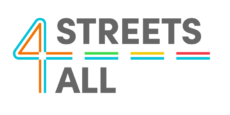about us
About Streets4All
Urban space is scarce and transport facilities use a significant amount (~20%) for roads, parking, and other uses. This space has been inequitably preferring motorized modes, in particular cars. Today, many cities target the UN’s Sustainable Development Goals by favoring people-centric planning after decades of car-centered planning.
Besides, urban street space is often idling. Congested streets and avenues during peak hours are often underutilized in off-peak hours. On-street parking in residential areas is scarce overnight but idling during the day when residents leave to work. So, planners could reallocate unused street space for other transport modes (e.g., bus lanes) or urban functions (e.g., markets, promenades), equitably. Such approaches exist today, e.g., nighttime parking or on-street weekend markets. However, they are local and static. They follow a fixed rule or they are temporary like tactical urbanism, e.g., pop-up cycle lanes. Overall, they are not demand-responsive and do not adapt to changing requirements of accessibility or mobility.
The limited literature points to an increase in the dispute for scarce urban space. STREETS4ALL is a project funded by Fundação para a Ciência e a Tecnologia (Project Ref. PTDC/ECI-TRA/3120/2021) that proposes an Equitable and Dynamic Allocation of Urban Street Space to accommodate the future multi-modal and multi-functional street’ uses. The objective of the project includes proposing methodologies for site selection of equitable allocation of space, street design and techonological solutions that can adapt its function and use equitably for all modes over time, according to some periodicity (e.g., an hour, few hours, or days) and at pre-timed periods (e.g., peak or off-peak, day or night time).
Our Mission
We want Equitable and Dynamic Allocation of Urban Street Space to a multi-modal and multi-functional street’ uses.
Keywords
- Dynamic road space allocation;
- Place;
- Movement;
- Inclusion;
- Urban Dynamics;
- Mobility For All.
Allocating road space dynamically over time
“The main goal is to accommodate the many uses and functions that the public space may have, with fluctuations of intensity and type of demand over time, while addressing severe problems of today’s cities, such as congestion, sustainability, equity, and safety. Big data, Information and Communication Technology (ICT) and Intelligent Transportation Systems (ITS) can be used as relevant tools for designing adaptive road space solutions”
Reference: Valença, G., Moura, F., & Morais de Sá, A. (2021). Main challenges and opportunities to dynamic road space allocation: From static to dynamic urban designs. Journal of Urban Mobility, 1, 100008. https://
